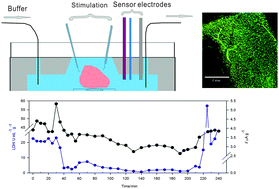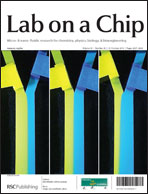A microfluidic device has been developed to maintain viable heart tissue samples in a biomimetic microenvironment. This device allows rat or human heart tissue to be studied under pseudo in vivo conditions. Effluent levels of lactate dehydrogenase and hydrogen peroxide were used as markers of damaged tissue in combination with in situ electrochemical measurement of the release of reactive oxygen species (ROS). The parameters for perfusion were optimized to maintain biopsies of rat right ventricular or human right atrial tissue viable for up to 5 and 3.5 hours, respectively. Electrochemical assessment of the oxidation current of total ROS, employing cyclic voltammetry, gave results in real-time that were in good agreement to biochemical assessment using conventional, off-chip, commercial assays. This proof-of-principle, integrated microfluidic device, may be exploited in providing a platform technology for future cardiac research, offering an alternative approach for investigating heart pathophysiology and facilitating the development of new therapeutic strategies.

You have access to this article
 Please wait while we load your content...
Something went wrong. Try again?
Please wait while we load your content...
Something went wrong. Try again?


 Please wait while we load your content...
Please wait while we load your content...